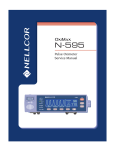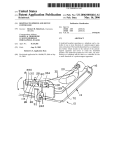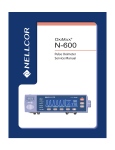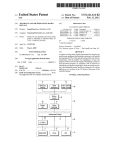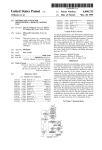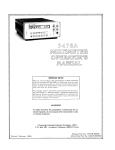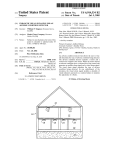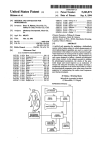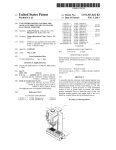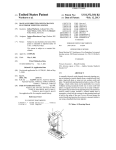Download Interface device and method for a monitoring network
Transcript
US006792396B2 (12) United States Patent (10) Patent N0.: Inda et al. (54) (75) US 6,792,396 B2 (45) Date of Patent: INTERFACE DEVICE AND METHOD FOR A W0 WO 00/25284 A2 MONITORING NETWORK W0 WO 00/42911 7/2000 W0 WO 01/43631 A1 6/2001 W0 W0 02/064032 A2 8/2002 Inventors: Allan G. Inda, Milwaukee, WI (US); Daniel J. NOWicki, Cedarburg, WI (US); Michael .I. Horvath, Port _ Ryzin, PeWaukee, WI (Us) _ _ Vargas, Home—l3ased Momtormg of Cardiac Patents, Jun. 1998, IEEE Article, vol.: 4793, pp. 133—136.* Sukuvaara et al., “Intelligent Patient Monitor— Its Function and User Interface”, Jul. 1992, IEEE Article, vol.:2485, pag (73) AssigneeZ GE Medical Systems Information Technologies, Inc» M?Waukee> WI Notice: 5/2000 OTHER PUBLICATIONS Washington, WI (US); Patrick A. Van ( >l< ) Sep. 14, 2004 (US) s 373—376.* Subject to any disclaimer, the term of this “OctanetTM patent is extended or adjusted under 35 (81—page product manual); 418264—003, Revision B; GE U_S_C_ 154(k)) by 69 days_ Marquette Medical Systems, Inc. (Jan. 14, 2000). “Octacomm Connectivity Device Operator/Service Manual”, (155—page product manual); SoftWare Versions 1 (21) Appl, N()_j 10/109,542 _ Connectivity Device Service' ' Manual”; and 2; 418264—001, Revision C; GE Marquette Medical (22) Flled: Mar‘ 28’ 2002 Systems, Inc. (Jan. 8, 1999). (65) Prior Publication Data Search Report, GB 03064771, Jul. 10, 2003. US 2003/0187618 A1 Oct. 2, 2003 _ _ * cited by eXammer (51) Int. Cl.7 ............................................... .. G06F 11/00 52 US. Cl. ......................... .. 702/188; 702/19; 702/32; ( ) 702/121; 702/188; 340/539.22, 340/870.06; _ _ (58) Field of Search ............................ .. 702/19, 21, 32, . . pmlmy Ex”m"7e’—Ma.rC 5" Hoff Assistant Examzner—El1as Desta 375/220’ 600/301’ 455/557 (74) Attorne A em or Firm—Audrus Sceales Starke & SaWaH 702/33, 121, 122, 182, 183, 186, 187, 188, FOR 103, 104, 115, 119, 134, 135, 170, 171; 340/870.06, 870.27, 573.3, 539.22; y’ g (57) 455/657; 375/220; 600/305, 301; 128/846 ’ ’ ’ ABSTRACT An interface device receives data from a plurality of sensors and transmits the data over a communication network to one (56) References Cited or more of a plurality of monitors. The interface device is capable of operating in both a peripheral mode of operation US. PATENT DOCUMENTS 5 465 082 A and a stand-alone mode of operation for the plurality of * 11/1995 Chaco ~~~~~~~~~~~~~~ " 340/8255,‘ monitors. In another embodiment, a monitor is connected to 5:867:821 A * 2/1999 Ballantyne et aL __________ __ 705/2 a plurality of interface devices by Way of a communication 6,440,071 B1 8/2002 slayton et a1_ netWork. A separate visible physical communication link or 1/2003 Dalal ........................ .. 607/32 6/2003 Nielsen et a1. ............ .. 600/513 other identi?cation link is used to visually identify Which of the interface devices is serving as a peripheral device for the 2003/0003127 A1 * 2003/0120164 A1 * monitor. FOREIGN PATENT DOCUMENTS W0 WO 92/04806 A1 3/1992 36 Claims, 8 Drawing Sheets 1 1O \ 2B ' l 24 INTERFACE DEVICE | CENTRAL MONITOR I l : 26 PATIENT 26 “'1 MONITOR PATIENT MONITOR I I_____.-__|__l l 20\ 12 1s 25 22 INTERFACE PATIENT DEVICE 1B3 27 [ DEVICE 148 / 2a 14 NSF 14b 15 14c 18b RESP 18c 14d UROMETER 18 14 INTERFACE MONITOR CO2 INTERFACE DEVICE 2s INTERFACE DEVICE :5 U.S. Patent Sep. 14, 2004 Sheet 3 of 8 US 6,792,396 B2 201 INTERFACE DEVICE LEDs ~64 66- COM COMPUTER '- ______ __-‘ I MEMORY .L 76’| p L l ‘1 —----1 IDINFO PHD | PROGRAM 78x2 DEVICE LIST | MEMORY \bqz I : 68 | SENSOR INTERFACES l l “74 ___....__.r.__2,_._.__ ( 62 T__I 18 “ r’ SPO2 18a ) |_ F1 ?sokLj VENT Y18b UROMETER z184: 18 / FIG 3 - U.S. Patent Sep. 14, 2004 Sheet 4 of 8 US 6,792,396 B2 91 ,_J + ACQUIRE DATA p PERIPHERAL MODE TRANSMIT DATA 32 TO SELECTED MONITOR STAND-ALONE 94w TRANSMIT DATA TO MULTIPLE l MONITORS II DISPLAY DATA f9?) AT SELECTED MONITOR ________l 95.\ DISPLAY DATA AT MULTIPLE MONITORS l_____.v FIG. 4 U.S. Patent Sep. 14, 2004 Sheet 5 of 8 US 6,792,396 B2 1, 100 J1o2 INTERFACE DEVICE REQUESTS TO ASSOCIATE COM LINK PRESENT 7 / NO _,1os MONITOR VALIDATES PACKET AND SENDS ACK TO INTERFACE DEvICE r110 SET LED TO PACKET VALID ? FLASHING YELLOW SET LED TO SOLID YELLOW “1 12 114 MONITOR ON NETWORK '2 N0 _,116 SET LED To SOLID GREEN ' INTERFACE DEVICE " SLEEPS TWO SECONDS “ 11s FlG- 5 U.S. Patent Sep. 14, 2004 Sheet 7 of 8 US 6,792,396 B2 US 6,792,396 B2 1 2 INTERFACE DEVICE AND METHOD FOR A MONITORING NETWORK interface, a microprocessor, and a memory. The communi cation interface is adapted to connect the interface device to a communication netWork to transmit data acquired by the interface device using a plurality of sensors over the com FIELD OF THE INVENTION munication netWork. The memory is programmed to provide the interface device With a peripheral mode of operation and a stand-alone mode of operation. In the peripheral mode of operation, the interface device operates as a peripheral This invention relates to monitoring systems and, in particular, relates to interface devices and methods used in a monitoring netWork to acquire data from a system under test. 10 BACKGROUND OF THE INVENTION alone device for multiple ones of the plurality of monitors. In particular, in the stand-alone mode of operation, the Monitoring netWorks and devices are knoWn for moni interface device operates as a stand-alone device available to transmit the data from the sensors to multiple ones of the toring systems under test. For example, in medical applications, patient monitors are knoWn for monitoring patients. A typical patient monitor includes a display, one or more operator input devices, one or more input ports for connecting the monitor to sensors that acquire data from the patient, and a microprocessor or other signal processor for 15 tem comprises a communication netWork, a sensor, an A large variety of sensors exist that may be used for data acquisition. For example, in medical applications, it may be the plurality of monitors is coupled to the communication desirable to receive data from sensors such as a carbon dioxide (CO2) sensor, a ventilator sensor, a urometer sensor, a pulse oximetry (SPO2) sensor, an ECG sensor, a respira netWork. The interface device has a peripheral mode of operation and a stand-alone mode of operation. The interface 25 device operates as a peripheral device for a selected one of the plurality of monitors in the peripheral mode of operation, and operates as a stand-alone device available to transmit the types, a Wide range of speci?c sensors exist that are avail data to each of the plurality of monitors in the stand-alone able from different manufacturers, and it is desirable to be able to provide health care facilities With the option of connecting patient monitors to a variety of different sensors mode of operation. According to another preferred aspect, a monitoring sys available from different sensor manufacturers. Interface devices are sometimes used to increase the number and/or variety of sensors that can be used to acquire data for a monitoring device. Often, one or more such 35 interface devices are connected to a communication netWork along With one or more monitoring devices. Aneed exists for an interface device that can operate in a variety of modes of operation. For example, in some situations, it is desirable to have an interface device that operates in a stand-alone mode 40 of operation, e.g., by transmitting data over a communica tion netWork to a variety of monitoring devices. This alloWs tem comprises a communication netWork, a plurality of sensors, a monitor, a plurality of interface devices, and an identi?cation link. The plurality of sensors are capable of acquiring data from a plurality of systems under test. The monitor has a display and is coupled to the communication netWork. The plurality of interface devices are coupled to respective ones of the plurality of sensors to receive the data from the systems under test. The plurality of interface devices are also coupled to the communication netWork. A selected one of the plurality of interface devices operates as a peripheral device for the monitor. The identi?cation link provides a separate physical connection betWeen the monitor the data from the sensors to be made available at any monitoring device that Wishes to vieW the data. In other instances, it is desirable to have an interface device that plurality of monitors by Way of the communication netWork. According to another preferred aspect, a monitoring sys interface device, and a plurality of monitors. The sensor is capable of acquiring data from a system under test. The interface device is coupled to the sensor to receive the data from the system under test. The interface device and each of processing the data acquired from the patient. tion sensor, an invasive or non-invasive blood pressure sensor, and so on. Within each of these different sensor device for one of a plurality of monitors. In the stand-alone mode of operation, the interface device operates as a stand 45 serves as a peripheral device for a monitoring device. For example, it may be desirable for the interface device to operate from an operator’s perspective as if the interface device is directly connected to the monitoring device, or in some other manner Which results in the operator perceiving the monitoring device as being more closely associated With the particular interface device than With other interface and the selected one of the plurality of interface devices to thereby provide a visual indication Which one of the plural ity of interface devices is operating as the peripheral device for the monitor. BRIEF DESCRIPTION OF THE DRAWINGS FIG. 1 is a block diagram of a patient monitoring system according to a preferred embodiment; FIG. 2 is a block diagram shoWing a patient monitor of the system of FIG. 1 in greater detail; devices on the communication netWork. FIG. 3 is a block diagram shoWing an interface device of Additionally, such interface devices and monitoring device are often connected to a communication netWork 55 along With other interface devices and monitoring devices. the system of FIG. 1 in greater detail; FIG. 4 is a ?oWchart shoWing the operation of the system When establishing a netWork connection betWeen a particu of FIG. 1 in either a stand-alone mode of operation or a lar patient monitoring device and a particular interface peripheral mode of operation; device, a need exists for a Way to ensure that the correct tWo FIG. 5 is another ?oWchart shoWing operation of an devices are connected together and to make connecting the tWo devices together as easy for the operator as possible. interface device to associate With a monitor in the system of FIG. 1; A monitoring system and method that meets one or more of these needs Would be highly desirable. BRIEF SUMMARY OF THE INVENTION According to a ?rst preferred embodiment, an interface device for a monitoring system comprises a communication 65 FIG. 6 is a screen display of a monitor in the system of FIG. 1 in Which the monitor displays data from an interface device alongside the monitor’s oWn data; FIG. 7 is a screen display of a monitor in the system of FIG. 1 in Which the monitor displays data from an interface device merged along With its oWn data; and US 6,792,396 B2 4 3 operation of the monitor 12. The identi?cation information 48 includes an identi?er by Which the monitor 12 is iden FIG. 8 is a screen display of a monitor in the system of FIG. 1 in Which the monitor displays its oWn data alongside data from another monitor, and With the data from the other monitor being merged With data from an interface device. DETAILED DESCRIPTION OF PREFERRED EMBODIMENTS Referring noW initially to FIGS. 1—3, an overvieW of a monitoring system 10 according to a preferred embodiment is shoWn. The monitoring system 10 comprises a monitor 12, 10 a ?rst plurality of sensors 14, an interface device 16, a second plurality of sensors 18, a communication netWork 20, an identi?cation adapter 22, a central monitor 24, a plurality of additional monitors 26, and a plurality of additional interface devices 28. As shoWn in FIG. 2, Which shoWs the monitor 12 in 15 ti?ed for communication on the communication netWork 20. The device list 50 is a list of devices (monitors, interface devices) active on the communication netWork 20. The interface device 16 is connected to the second plu rality of sensors 18. With reference to FIG. 3, Which shoWs the interface device 16 in greater detail, the interface device 16 includes a plurality of input ports 60, a computer 62, a plurality of indicators 64 such as LEDs, and a communica tion interface 66. The input ports 60 are connected to the sensors 18 and receive the data acquired by the sensors from the patient 29. The communication interface 66 connects the interface device to the communication netWork 20 to trans mit the data from the sensors 18 over the communication netWork 20. The computer further includes a microprocessor 68 and a memory 70. The memory 70 includes memory that greater detail, the monitor 12 includes a plurality of input ports 30, a computer 32, a display 34, an input device 36 and stores programs executed by the microprocessor 68 for operation of the interface device, such as program memory a communication interface 38. The computer further includes a microprocessor 40 and a memory 42. The memory 42 is programmed and stores such things as one or 72 and sensor interface memory 74, as Well as memory that stores other information such as identi?cation information 76 and a device list 78. The sensors 18 may be completely different or may more monitor programs 44, one or more interface programs 46, identi?cation information 48, and a device list 50. The monitor 12 is connected to the ?rst plurality of sensors 14. These connections may be made by analog or overlap With the sensors 14. Again, these connections may 25 be made by analog or digital (parallel or serial) communi hardWired or Wireless connection of the sensor to the moni cation links, by direct connection of the sensor to the interface device 16, or by another arrangement. The sensors 18 are preferably connected to the interface device 16 by tor 12, or by another arrangement. In the preferred Way of identical input ports 60 (e.g., RS-232 ports) disposed embodiment, the sensors 14 are connected to the monitor 12 on the interface device 16, Which provide a standard com munication interface for connecting sensors from various manufacturers to the interface device 16. The sensors 18 may include a variety of different types of sensors that acquire different types of data as described above in con digital (parallel or serial) communication links, by direct by Way of input ports 30. In one embodiment, the input ports 30 are each uniquely con?gured for a particular type of sensor, such that a given input port 30 may only be used With a particular type of sensor. Alternatively, the input ports may be identical ports, such as RS-232 ports, to provide a standard communication interface for connecting sensors from various manufacturers to the monitor 12. A combina tion of these tWo approaches may also be used. The sensors 14 may include a variety of different types of sensors that acquire different types of data. In the preferred embodiment, the monitor 12 is a portable patient monitor 35 embodiment, the sensors 18 are used by the interface device 16 to acquire physiological data from the patient 29. In FIG. 1, the sensors 18 are shoWn as including an SPO2 sensor 18a, a ventilator sensor 18b, and a urometer sensor 18c. 40 The interface device 16 is programmed to support each of the different types of sensors 18 to Which it is connected. To and is used to continuously monitor parameters from a patient 29. In this embodiment, the sensors 14 are used by this end, the interface device includes the interface programs 74 Which are useable to interpret and process the data acquired by the sensors 18. The sensors 18 each include the monitor 12 to acquire physiological data from the patient 29 and may include, for example, a ventilator sensor, a urometer sensor, a pulse oximetry (SPO2) sensor, a carbon junction With the sensors 14. In the patient monitoring 45 memory (not shoWn) that stores identi?cation information (e.g., device type) for the sensor 18. When one of the sensors dioxide (CO2) sensor, an electrocardiograph (ECG) sensor, 18 is initially connected to the interface device 16, this a respiration sensor, an invasive blood pressure sensor, a information is transmitted to the interface device 16 so that the interface device 16 can determine the type of sensor to Which it is connected. Based on this information, the inter face device 16 uses a particular interface program 74 to non-invasive blood pressure (NBP) sensor, cardiac output sensor, impedance cardiography sensor, electroencephalo graph (EEG) sensor and so on. In FIG. 1, the sensors 14 are shoWn as including an NBP sensor 14a, and ECG sensor 14b, a respiration sensor 14c and a CO2 sensor 14d. The monitor 12 is programmed to support each of the different types of sensors 14 to Which it is connected. To this end, the interpret and process the data from the particular sensor 18. In this regard, it may be noted that the interface device 16 may be used to serve as a universal interface device for a 55 monitor 12 includes the interface programs 46 Which are variety of different types of sensors. In other Words, When a decision is made to support a neW type of sensor, interface softWare for the neW type of sensor is developed and useable to interpret and process the data acquired the dif ferent sensors Which are supported by the monitor 12. The display 34 and the input device 36 of the monitor 12 provide an operator interface by Which operator inputs are acquired and data acquired by the sensors 14 and 18 is displayed to the operator. The communication interface 38 connects the monitor 12 to the communication netWork 20, alloWing the monitor 12 to transmit information to and programmed into the interface device 16. Any type of monitor or other device that is connected to the communi cation netWork 20 then has access to the data acquired by the neW type of sensor by Way of the interface device 16. There is no need to develop interface softWare for each of these different types of monitors individually. It may be noted that in some cases sensors may be tion netWork 20. The monitor program 44 is one or more connected to a monitor or interface device only indirectly and a certain amount of preprocessing may occur before data programs executed by the microprocessor 40 to control from a particular sensor is transmitted to the monitor or the receive information from other devices on the communica 65 US 6,792,396 B2 5 6 interface device. For example, in connection With the ven tilator sensor 18b, this sensor is likely to be provided as part of or attached to a ventilator system having its oWn computer system and an output port. The output port of the ventilator system may be connected to an input port 60 of the interface device 16, and data may be transferred to the interface device 16 via the connection made betWeen these tWo ports. The interface device 16 is therefore connected to the sensor there is little opportunity for confusion on the operator’s part as to Which tWo devices are connected together. This avoids a situation in Which the operator is under a mistaken impression that the monitor 12 is con?gured to receive data for one patient from one interface device, When in fact the monitor 12 is actually con?gured to receive data for a different patient from a different interface device. Of course, it Would also be possible to transmit the data acquired by the 18b by Way of the ventilator computer system, and the data from the ventilator sensor 18b is made available to the 1O interface device 16 by the ventilator computer system, as opposed to by the sensor 18b itself directly. Similar arrange ments may be used for other devices such as respirators. In other cases, particular sensors may be directly connected to the monitors and interface devices. The communication netWork 20 connects the patient The identi?cation adapter 22 includes memory (not shoWn) that stores device type information that is transmit ted to the interface device 16 and that is used by the interface device 16 to distinguish the identi?cation adapter 22 from 15 some other type of device, such as a sensor. This is akin to the device type information stored and transmitted by the monitor 12, the interface device 16, the central monitor 24, the patient monitors 26 and the interface devices 28. The sensors 18. This alloWs the interface device 16 to recogniZe that it is connected to an identi?cation adapter (and thus, by communication netWork 20 may be a hardWired or Wireless netWork and may be a local area netWork, metropolitan area netWork, or Wide area netWork such as the Internet. In the Way of the identi?cation adapter, to a patient monitor) as opposed to some other type of device, such as a sensor. Referring noW also to FIG. 4, an overvieW of the opera embodiment of FIG. 1, the communication netWork is a hospital monitoring netWork or other patient monitoring netWork. The patient monitors 12, 26 and interface devices 16, 28 may be located throughout different rooms of the sensors 18 by Way of the dedicated communication link 25 instead of by Way of the communication netWork 20. 25 healthcare facility. The monitors 26 may be the same or tion of the system 10 is illustrated. The interface device 16 has tWo modes of operation, namely, a peripheral mode of operation and a stand-alone mode of operation. In the peripheral mode of operation, the interface device similar in construction and operation to the monitor 12, and 16 operates as a peripheral device for one of the monitors 12, the interface devices 28 may be the same or similar in 26. By Way of eXample, it is assumed herein that the construction and operation to the interface device 16. The interface device 16 is con?gured to operate as a peripheral patient monitors 26 and the interface devices 28 are con for the monitor 12, although the interface device 16 could nected to additional sensors that acquire physiological data just as easily be con?gured at other times to operate as a peripheral for one of the other patient monitors 26. In FIG. from other patients. For simplicity, the additional sensors 4, at step 91, data is acquired from the patient 29 using the and additional patients are not shoWn in FIG. 1. Other types sensors 18 connected to the interface device 16. Assuming of monitors or interface devices may also be used. For eXample, one of the monitors 26 may be a clinical informa 35 the interface device 16 is operating as a peripheral device for the monitor 12, then the data is transmitted from the inter tion system, Which is in essence a device that monitors and face device 16 to the monitor 12 at step 92. At step 93, the stores data transmitted on the communication netWork 20. Other non-monitoring, non-data acquiring devices may also be connected to the netWork 20, although these devices are not shoWn in FIG. 1. 40 The identi?cation adapter 22 is disposed betWeen the monitor 12 and the interface device 16. Preferably, the identi?cation adapter 22 is embedded in an electrical cable 27 Which forms a dedicated communication link 25 betWeen the monitor 12 and the interface device 16. The dedicated data is displayed by the monitor 12. In one embodiment, in the peripheral mode of operation, the data acquired by the interface device 16 is available to remaining ones of the plurality of monitors 26 only through the monitor 12. Thus, the system 10 may be con?gured such that data acquired by any of the monitors 12 and 26 may be displayed at any of the other monitors 12 and 26. This alloWs data acquired from one patient to be vieWed by a physician Without the physician necessarily having to be at the patient’s bedside. In the peripheral mode of operation, the data acquired by the interface device 16 is available to the monitors 26 along With the data from the monitor 12. HoWever, the monitors 26 are not permitted to directly access the data acquired by the interface device 16; rather, communication link 25 is separate from the communication netWork 20 and provides a direct connection betWeen the monitor 12 and the interface device 16. In the preferred embodiment, the cable 27 connects to the monitor 12 by Way of an open one of the input ports 30 used to connect the monitor 12 to the sensors 14, and connects to the interface device 16 by Way of an open one of the input ports 60 used access to the data acquired by the interface device 16 is to connect the interface device 16 to the sensors 18. The granted through the monitor 12. Thus, When the interface cable 27 is preferably bi-directional, so that either end may be coupled to either the monitor 12 or the interface device 16. 55 device 16 is in the peripheral mode of operation, access to the data acquired by the interface device 16 is obtained in a manner Which is substantially the same as the manner in Which access is obtained to the data acquired by the monitor In one embodiment, data acquired by the interface device 16 using the sensors 18 is transmitted to the monitor 12 by 12. Data acquired by the interface device 16 using the sensors 18 is merged With data acquired by the monitor 12 using the sensors 14. From an operator interface perspective, Way of the communication netWork 20 and not the dedicated communication link 25. Alternatively, if the communication link 25 has suf?cient bandWidth, data may be transmitted by Way of the communication link 25. In this embodiment, the data from the interface device 16 is vieWed at one of the monitors 26 by vieWing the data acquired by the monitor 12, purpose of the cable 27 is limited to providing a reliable Way and little or no differentiation exists betWeen data acquired of determining Which tWo devices (i.e., Which interface device and Which patient monitor) are connected together. by the interface device 16 and data acquired by the monitor Because the operator can see a physical, hardWired connec 12. Of course, other con?gurations are also possible. Additionally, the monitors 26 each maintain a list 50 of tion betWeen the monitor 12 and the interface device 16, interface devices 28 on the communication netWork 20. The 65 US 6,792,396 B2 7 8 monitors 26 can then be con?gured to display this list to an monitor 12 initiate an auto-association process in Which the interface device 16 and the monitor 12 establish communi cation With each other and the interface device 16 becomes a peripheral of the monitor 12. From the standpoint of a operator (in response to the reception of appropriate operator inputs), such that an operator may select one of the interface devices 28. For example, an operator at one of the operator monitors 26 may Wish to select a particular one of the interface devices 28, adjust alarm thresholds for a particular one of the parameters monitored by the selected interface device 28, and then monitor the selected parameter to thereby be alerted When the parameter exceeds the alarm threshold. In the preferred embodiment, When the interface device 16 is in the peripheral mode of operation, and When human operator, the operator connects the interface device 16 and the monitor 12 With the cable 27, and this initiates an auto-detect sequence Wherein the interface device 16 and the monitor 12 detect the presence of the cable 27 and the interface device 16 enters the peripheral mode of operation. 10 an operator of one of the monitors 26 displays a list of the interface devices on the communication netWork 20, the interface device 16 is not included among the list of interface devices displayed to the operator. It may also be noted that, in the peripheral mode of operation, some of the data transmitted to the monitor 12 by the interface device 16 may not be displayed by the monitor or 26. Preferably, step 102 is implemented by the interface 15 For example, intravenous (IV) pump data may be passed through the monitor 12 to a clinical information system for charting. Other parameters unknoWn to the monitor 12 may be passed through as Well. For example, if a particular sensor 25 interface device 16, the data from the particular sensor 18 may simply be passed through the monitor 12 to the other monitors 26 on the rest of the communication netWork 20. number of the interface device 16. This is advantageous in that the unit name and bed number of the monitor 12 can be nication netWork 20, depending on Which monitors 12, 26 are con?gured to receive such data. As previously noted, in 35 40 At step 104, if the dedicated communication link 25 is not present, then the process 100 returns to step 102. On the other hand, if the dedicated communication link 25 is present at step 104, then the identi?cation information is successfully transmitted by Way of the dedicated commu monitors 12, 26 may be con?gured to display data from the interface device 16 and to silence alarms, adjust alarm threshold values, initiate graph generating functions, change patient demographic and identi?cation information, and automatically con?gured to match that of a location Within the facility by Way of the data sent from the interface device 16 via the dedicated communication link 25. In this example, the unit name and bed number of the interface device 16 pre-con?gured such that it matches the physical location of the interface device 16 With the facility, such as a room number and bed location. the peripheral mode of operation. When the interface device 16 is in the stand-alone mode of operation, the interface device 16 appears on this list for each of the monitors 12, 26. In response to suitable operator inputs, any subset of the the interface device 16 is available to enter the peripheral mode of operation. The identi?cation information may include the unit name, bed number and IP address of the interface device 16. Sending the unit name and bed number is advantageous if the monitor 12 is a portable monitor Which is susceptible to being moved from location to location Within a facility. The monitor 12 may then further prompt the operator to con?rm the unit name of the interface device 16, to provide further assurance that the correct tWo devices are connected together. The monitor 12 may also change its oWn unit name and bed number to be similar to that of the unit name and bed In the stand-alone mode of operation, the interface device 16 operates as a stand-alone device for the monitors 12, 26. The interface device 16 is available to transmit data directly to any or all of the monitors 12, 26 by Way of the commu one embodiment, each of the monitors 12, 26 maintains a list of interface devices 16, 28 Which are present on the com munication netWork 20 and Which are available to operate in device 16 Which attempts to transmit identi?cation informa tion (or a “packet”) on the dedicated communication link 25 at periodic intervals. This transmission provides an indica tion to any listening device (particularly, the monitor 12) that 12 but may instead be passed through the monitor 12 to one of the monitors 26, such as a clinical information system. 18 is not supported by the monitor 12 but is supported by the More speci?cally, by Way of example, at step 102, the interface device 16 requests to associate With a monitor 12 nication link 25 to the monitor 12. The process 100 then others. It may be noted that although the interface device is proceeds to step 106. At step 106, monitor 12 validates the identi?cation infor available to transmit data to multiple ones of the monitors 12 mation and sends an acknoWledgment to the interface device in the stand-alone mode of operation, 26, the subset of 16 by Way of the communication link 25. The acknoWledg ment transmitted by the monitor 12 includes identi?cation 45 monitors Which are con?gured to receive the data may some information (e.g., IP address) for the monitor 12. At step 108, the interface device 16 performs a checksum operation times actually consist of Zero monitors. Referring again to FIG. 4, FIG. 4 shoWs operation of the to con?rm that the identi?cation information from the moni tor 12 is valid. If the checksum operation is not successful, this indicates a faulty connection betWeen the interface interface device 16 in the case Where multiple monitors 12, 26 are con?gured to receive the data from the interface device 16. Thus, in FIG. 4, in the stand-alone mode of operation, the data from the interface device 16 is transmit ted to multiple ones of the monitors 12, 26 at step 94. At step 95, the data is displayed by the multiple ones of the monitors 12, 26. Referring noW to FIG. 5, an embodiment of an association process 100 in Which the interface device 16 enters a peripheral mode of operation is illustrated. By default, the interface device 16 is in the stand-alone mode of operation unless action is taken by an operator to Which causes the system 10 to con?gure the interface device 16 in the peripheral mode of operation. Upon detecting that the inter face adapter 22 has been connected to one of the input ports 60 of the interface device 16, the interface device 16 and the 55 device 16 and the monitor 12. Accordingly, at step 110, operator feedback is provided indicating the faulty connec tion on the dedicated communication link 25 (e.g., a ?ashing yelloW LED 64 on the interface device 16), and the process 100 returns to step 102. Conversely, at step 112, if the checksum operation is successful, then operator feedback is provided indicating an “association pending” condition (e.g., a solid yelloW LED 64 on the interface device 16), and the process 100 proceeds to step 114. At step 114, the interface device 16 attempts to 65 establish a connection With the monitor 12 on the commu nication netWork 20. If no connection can be established, then the process returns to step 102. US 6,792,396 B2 9 10 operator feedback is provided indicating successful associa played at the monitor 12 in a split vieW mode, such that the right-hand side of the screen shoWs the data acquired using tion (communication on both the netWork 20 and the link the sensors 14 and the left-hand side of the screen shoWs 25). The operator feedback may take the form, for example, data acquired using the sensors 18. The left and right are potentially tWo different patients, but they could be the same If connection is established at step 114 then, at step 116, of a solid green LED 64 on the interface device 16. After step 116, the mode of operation of the interface device 16 is thereby changed from the stand-alone mode of operation to a peripheral mode of operation. The process then proceeds to step 118, Waits for a predetermined amount of time (e.g., tWo seconds), and then returns to step 102. By virtue of regularly returning to step 102, the interface device 16 regularly con?rms that it is still connected to the monitor 12. During this time, the interface device 16 may transmit real time Waveform data and/or numeric parameter data to the monitor 12. patient. In FIG. 7, the interface device 16 is in a peripheral mode of operation. The data from the interface device 16 in FIG. 6 is displayed by the monitor 12, except that the monitor 12 has merged this data in With its oWn local data. It appears that data from the interface device 16 is local to the monitor 12. In FIG. 8, one of the patient monitors 26 is displaying data 15 In the preferred embodiment, the cable 27 is provided is a remote vieW of the data acquired by the monitor 12. The data from the monitor 12 contains a combination of data that Which forms a communication link 25 betWeen the interface device 16 and the monitor 12. The cable 27 provides a is locally acquired by the monitor 12 and data acquired by physical connection betWeen the interface device 16 and the monitor 12 Which is visible to the operator, and therefore the interface device 16. Many changes and modi?cations may also be made to the serves to visually identify Which tWo devices are connected invention Without departing from the spirit thereof. The scope of these changes Will become apparent from the together. Other types of physical connections may be used to implement a visual identi?cation link. For example, a device as simple as a string With mechanical or electronic keys at both ends may be used. If electronic keys are used, for example, the electronic keys may take the form of connec in a split vieW mode. The right side of the display is locally acquired data for the monitor 26. The left side of the display appended claims. 25 What is claimed is: 1. An interface device for a monitoring system, compris ing: tors Which each pin selectively tied high or loW. Each connector then represents a stored N-bit number (With N corresponding to the number of pins) Which is read by the a communication interface, the communication interface being adapted to connect the interface device to a communication netWork to transmit data acquired by monitor 12 at one end and the interface device 16 at the other the interface device using a plurality of sensors over the end. The monitor 12 and interface device 16 then locate each communication netWork; and other on the communication netWork 20 by locating the device With the matching key. Other arrangements are also a microprocessor and a programmed memory coupled to possible. It may also be noted that the use of a visual the microprocessor, the memory being programmed to identi?cation link may be employed not only With interface provide the interface device With a peripheral mode of operation and a stand-alone mode of operation; 35 devices that are capable of both a peripheral and stand-alone mode of operation, but also With interface devices that are Wherein, in the peripheral mode of operation, the interface device operates as a peripheral device for a ?rst one of only capable of a peripheral mode of operation. In alternative embodiments, no visible communication link is used (e.g., no identi?cation adapter 22, no commu a plurality of monitors, the ?rst monitor con?gured to 40 nication link 25, and so on), and the interface device 16 enters the peripheral mode of operation entirely in response to requests transmitted by Way of the communication net Work 20. For example, an operator input may be received at the monitor 12 Which indicates that the operator Wishes to have the interface device 16 con?gured to operate as periph eral for the monitor 12. Each interface device 16, 28 receive and process data from sensors that are coupled to the ?rst monitor and a system under test, and con?gured to execute a monitor program related to data acquired by the interface device from the plurality sensors; 45 Wherein, in the stand-alone mode of operation, the inter face device operates as a stand-alone device available to transmit the data from the sensors to multiple ones of the plurality of monitors by Way of the communication broadcasts its presence on the communication netWork 20 and each monitor 12, 26 maintains a list of interface devices available on the communication netWork 20. When the operator Wishes to select an interface device to be con?gured as a peripheral, a list of available interface devices is netWork. 2. An interface device according to claim 1, Wherein, in the peripheral mode of operation, the interface device transmits the data acquired by the displayed to the operator at the monitor 12. Operator inputs sensor to the one of the plurality of monitors, (ii) the are then received Which indicate the operator’s selection of data is accessible by remaining ones of the plurality of monitors only through the one of the plurality of a particular interface device 16, 28 to serve as a peripheral. 55 monitors; and The interface device 16 changes from the stand-alone mode of operation to the peripheral mode of operation in response Wherein, in the stand-alone mode of operation, the data is accessible by remaining ones of the plurality of monitors only through the one of the plurality of to receiving a request from the monitor 12 to enter the peripheral mode of operation. To provide safe assurance that the correct tWo devices are associated, a device name may monitors, and (ii) the data is displayed by the respective be made visible on the housing of the interface device 16, Which the operator may then read and compare to the number of the interface device presented on the display of the monitor 12. Referring noW to FIGS. 6—8, a plurality of exemplary screen displays are shoWn. In FIG. 6, the interface device 16 is in the stand-alone mode of operation. The data is dis displays of the more than one of the plurality of monitors. 3. An interface device according to claim 1, Wherein the data transmitted by the interface device is physiological data 65 pertaining to a physiological condition of a human patient. 4. A monitoring system comprising: a communication netWork; US 6,792,396 B2 11 12 test, and the interface device being coupled to the communication netWork; and a plurality of monitors, each of the plurality of monitors a sensor, the sensor being capable of acquiring data from a system under test; an interface device, the interface device being coupled to the sensor to receive the data from the system under test, and the interface device being coupled to the being coupled to the communication netWork; Wherein the interface device has a peripheral mode of operation and a stand-alone mode of operation, the interface device operating as a peripheral device for a selected one of the plurality of monitors in the periph eral mode of operation, and the interface device oper communication netWork; and a plurality of monitors, each of the plurality of monitors being coupled to the communication netWork; and Wherein the interface device has a peripheral mode of operation and a stand-alone mode of operation, the interface device operating as a peripheral device for a selected ?rst one of the plurality of monitors in the 10 peripheral mode of operation, and the interface device operating as a stand-alone device available to transmit the data to each of the plurality of monitors in the stand-alone mode of operation; and Wherein, the ?rst monitor is con?gured to receive and 15 plurality of monitors communicate by Way of the process data from sensors that are coupled to the ?rst monitor and a system under test, and con?gured to execute a monitor program related to data acquired by the interface device from the plurality sensors. 5. A system according to claim 4, Wherein, in the peripheral mode of operation, the interface device transmits the data acquired by the sensor to the selected one of the plurality of monitors, 25 (ii) the data is displayed by the selected one of the plurality of monitors, and (iii) the data is accessible by remaining ones of the plurality of monitors only dedicated communication link to verify an identity of the interface device operating as the peripheral device for the selected one of the, plurality of monitors. 8. A system according to claim 4, Wherein the interface device sWitches from the stand-alone mode of operation to the peripheral mode of operation in response to receiving a request from the selected one of the plurality of monitors to enter the peripheral mode of operation. 9. A system according to claim 4, Wherein the interface device sWitches from the stand-alone mode of operation to the peripheral mode of operation in response to an operator input received at the selected one of the plurality of moni through the selected one of the plurality of monitors; and tors. Wherein, in the stand-alone mode of operation, the inter face device is available to transmit the data individually to each of the plurality of monitors, and the plurality of 10. A system according to claim 4, Wherein the monitor ing system is a patient monitoring system, Wherein the system under test is a human patient, and Wherein the data monitors are each con?gurable to receive the data acquired by the sensor directly from the interface device by Way of the communication netWork. ating as a stand-alone device available to transmit the data to each of the plurality of monitors in the stand alone mode of operation; and Wherein the identi?cation link comprises a dedicated communication link, Wherein the system further com prises a plurality of additional interface devices, and Wherein the interface device and the selected one of the 35 acquired from the human patient is physiological data. 11. Asystem according to claim 10, Wherein the sensor is one of an electrocardiograph sensor, a pulse oXimetry 6. A monitoring system comprising: sensor, a blood pressure sensor, and a carbon dioxide sensor, a communication netWork; cardiac output sensor, impedance cardiography sensor, elec a sensor, the sensor being capable of acquiring data from a system under test; an interface device, the interface device being coupled to the sensor to receive the data from the system under test, and the interface device being coupled to the communication netWork; a plurality of monitors, each of the plurality of monitors being coupled to the communication netWork; and 40 45 12. A system according to claim 10, Wherein the patient monitoring system is located in a healthcare facility. 13. A system according to claim 10, Wherein the interface device stores information identifying at least one of a unit name and a bed number With Which the interface device is associated, and Wherein the interface device transmits the at least one of the unit name and bed number to the selected one of the plurality of monitors. an identi?cation link, the identi?cation link providing a 14. A system according to claim 4, separate physical connection betWeen the interface device and the selected one of the plurality of monitors to thereby provide a visual indication that the interface device is operating as operating as the peripheral device for the selected one of the plurality of monitors Wherein the interface device has a peripheral mode of operation and a stand-alone mode of operation, the interface device operating as a peripheral device for a selected one of the plurality of monitors in the periph eral mode of operation, and the interface device oper troencephalograph sensor. Wherein the sensor is one of a ?rst plurality of sensors capable of acquiring data from the system under test, Wherein the system further comprises a second plurality of sensors, the second plurality of sensors being capable of acquiring data from the system under test; 55 Wherein the interface device includes a ?rst plurality of input ports, the ?rst plurality of input ports being coupled to respective ones of the ?rst plurality of sensors to receive data at the interface device from the ating as a stand-alone device available to transmit the ?rst plurality of sensors; and Wherein the selected one of the plurality of monitors includes a second plurality of input ports, the second data to each of the plurality of monitors in the stand alone mode of operation. 7. A monitoring system comprising: plurality of input ports being coupled to respective ones a communication netWork; of the second plurality of sensors to receive data at the selected one of the plurality of monitors from the second plurality of sensors. a sensor, the sensor being capable of acquiring data from a system under test; an interface device, the interface device being coupled to the sensor to receive the data from the system under 65 15. A monitoring system comprising: a communication netWork; US 6,792,396 B2 14 13 monitors, the utiliZation by the multiple ones of the plurality of monitors comprising, for each monitor, at a sensor, the sensor being capable of acquiring data from a system under test; an interface device, the interface device being coupled to the sensor to receive the data from the system under test, and the interface device being coupled to the least one of (a) displaying the data from the sensors and (b) storing the data from the sensors in an electronic patient chart. 17. Apatient monitoring system for a healthcare facility, communication netWork; the patient monitoring system comprising: a plurality of monitors, each of the plurality of monitors being coupled to the communication netWork; and Wherein the sensor is one of a ?rst plurality of sensors capable of acquiring data from the system under test, Wherein the system further comprises a second plurality 10 human patient, the ?rst set of data pertaining to physi ological measurements from the human patient; a second plurality of sensors, the second plurality of of sensors, the second plurality of sensors being capable of acquiring data from the system under test; Wherein the interface device includes a ?rst plurality of a communication netWork; a ?rst plurality of sensors, the ?rst plurality of sensors being capable of acquiring a ?rst set of data from a 15 input ports, the ?rst plurality of input ports being coupled to respective ones of the ?rst plurality of sensors being capable of acquiring a second set of data from the human patient, the second set of data pertain ing to additional physiological measurements from the human patient; sensors to receive data at the interface device from the a plurality of monitors, the plurality of monitors each being coupled to the communication netWork and each ?rst plurality of sensors; Wherein the selected one of the plurality of monitors includes a second plurality of input ports, the second including a respective display, the plurality of monitors plurality of input ports being coupled to respective ones including a ?rst monitor, the ?rst monitor having a ?rst of the second plurality of sensors to receive data at the selected one of the plurality of monitors from the plurality of input ports, the ?rst monitor being coupled second plurality of sensors; and to the ?rst plurality of sensors by Way of the ?rst 25 an interface device, the interface device being coupled to the communication netWork, the interface device hav ing a second plurality of input ports, the interface device being coupled to the second plurality of sensors Wherein, in the peripheral mode of operation, the data acquired by the ?rst plurality of sensors is displayed at the selected one of the plurality of monitors in a manner that is substantially indistinguishable from a manner in by Way of the second plurality of input ports; Which the data acquired by the second plurality of sensors is displayed; and Wherein, in the stand-alone mode of operation, the data acquired by the ?rst plurality of sensors is displayed at the selected one of the plurality of monitors in a manner that is readily distinguishable from a manner in Which 35 Wherein, in a ?rst mode of operation, the interface device operates as a peripheral device for the ?rst monitor, such that the interface device transmits the second set of data to the ?rst monitor, (ii) at least some of the second set of data is displayed by the ?rst monitor, and (iii) the second set of data is accessible by remaining ones of the plurality of monitors only through the ?rst the data acquired by the second plurality of sensors is displayed. monitor; and 16. An interface device for a patient monitoring system, comprising: a plurality of input ports, the plurality of input ports being capable of being connected to a respective plurality of plurality of input ports; Wherein, in a second mode of operation, the interface 40 device operates as a stand-alone device, such that the interface device transmits the second set of data by Way sensors to receive data acquired by the sensors from a of the communication netWork to more than one of the patient; plurality of monitors, and (ii) at least some of the a communication interface, the communication interface being adapted to connect the interface device to a communication netWork to transmit the data from the plurality of sensors over the communication netWork; a microprocessor and a programmed memory coupled to second set of data is displayed by the more than one of 45 the plurality of monitors. 18. A method of operation for a patient monitoring netWork, comprising: (A) acquiring data from a patient using sensors connected to an interface device; the microprocessor, the memory being programmed to provide the interface device With ?rst and second (B) operating the monitoring netWork With the interface modes of operation, Wherein, in the ?rst mode of operation of the interface device in a stand-alone mode operation, including (1) transmitting the data from the interface device to a device, the interface device operates as a peripheral device for a selected ?rst one of a plurality of monitors, such that the interface device transmits the data from the patient to the ?rst monitor, the ?rst monitor con ?gured to receive and process data from sensors that are coupled to the ?rst monitor and a system under test, 55 device from the stand-alone mode of operation to a peripheral mode of operation; and (D) operating the monitoring netWork With the interface device in the peripheral mode operation, including and con?gured to eXecute a monitor program related to data acquired by the interface device from the plurality (1) transmitting the data from the interface device to a selected ?rst one of the plurality of monitors, the ?rst monitor con?gured to receive and process data from sensors; and Wherein, in the second mode of operation of the interface device, the interface device is available to transmit the data from the sensors to multiple ones of the plurality of monitors by Way of the communication netWork for utiliZation by the multiple ones of the plurality of plurality of monitors, and (2) displaying the data at the plurality of monitors; (C) changing the mode of operation of the interface sensors that are coupled to the ?rst monitor and a 65 system under test, and con?gured to eXecute a moni tor program related to data acquired by the interface device from the plurality sensors, and US 6,792,396 B2 15 16 (D) operating the monitoring netWork With the interface device in the peripheral mode operation, including (2) displaying the data at the selected one of the plurality of monitors, Wherein, in the peripheral mode of operation, the data acquired by the interface device is available to remain ing ones of the plurality of monitors only through the (1) transmitting the data from the interface device to a selected ?rst one of the plurality of monitors, the interface device and the selected one of the plurality of monitors being connected by a dedicated commu selected one of the plurality of monitors. 19. A method according to claim 18, further comprising repetitively broadcasting a message from the interface nication link, and (2) displaying the data at the selected one of the device indicating that the interface device is available to enter the peripheral mode of operation. 20. Amethod according to claim 18, Wherein the changing 10 interface device and the selected one of the plurality of monitors over the dedicated communication link; step further comprises (1) transmitting a request from the selected one of the plurality monitors to the interface device to enter a peripheral mode of operation, and (2) receiving and responding to the request at the interface 15 Wherein, in the peripheral mode of operation, the data acquired by the interface device is available to remain ing ones of the plurality of monitors only through the selected one of the plurality of monitors. device. 21. Amethod according to claim 18, Wherein the interface 24. A monitoring system comprising: device is one of a plurality of interface devices, and Wherein the method further comprises maintaining a list of the plurality of interface device that are available to operate in ?rst means for acquiring a ?rst set of data from a system under test; second means for acquiring a second set of data from the the peripheral mode of operation, the list being maintained system under test; in memory devices of at least some of the plurality of monitors. 22. A method of operation for a patient monitoring netWork, comprising: plurality of monitors, and (E) exchanging identi?cation information betWeen the 25 means for displaying the ?rst set of data and the second set of data; and means for receiving the ?rst set of data and transmitting (A) acquiring data from a patient using sensors connected the ?rst set of data on a communication netWork, to an interface device, the interface device being one of Wherein, in a ?rst mode of operation, the means for a plurality of interface devices; receiving transmits the ?rst set of data exclusively to the means for displaying and, in a second mode of operation, the means for receiving broadcasts the ?rst (B) operating the monitoring netWork With the interface device in a stand-alone mode operation, including (1) transmitting the data from the interface device to a set of data on the communication netWork for reception by a plurality of devices capable of displaying the ?rst plurality of monitors, and (2) displaying the data at the plurality of monitors; set of data. 25. A monitoring system comprising: (C) changing the mode of operation of the interface device from the stand-alone mode of operation to a 35 peripheral mode of operation; (D) operating the monitoring netWork With the interface device in the peripheral mode operation, including (1) transmitting the data from the interface device to a selected ?rst one of the plurality of monitors, and (2) displaying the data at the selected one of the 40 being coupled to the communication netWork; plurality of monitors, operation, the list being maintained in memory devices ity of sensors to receive the data from the systems under 45 plurality of interface devices operating as a peripheral device for the monitor; and an identi?cation link, the identi?cation link providing a separate physical connection betWeen the monitor and the selected one of the plurality of interface devices to thereby provide a visual indication Which one of the plurality of interface devices is operating as the periph eral device for the monitor. 26. A system according to claim 25, Wherein the identi ?cation link comprises a communication link. 27. A system according to claim 26, Wherein the interface device and the monitor communicate by Way of the dedi cated communication link to verify an identity of the (F) displaying the list to a human operator, and receiving an operator selection indicating Which of the plurality of interface devices is available to serve in the periph eral mode of operation; Wherein, in the peripheral mode of operation, the data acquired by the interface device is available to remain ing ones of the plurality of monitors only through the selected one of the plurality of monitors. 23. A method of operation for a patient monitoring netWork, comprising: (A) acquiring data from a patient using sensors connected to an interface device; (B) operating the monitoring netWork With the interface selected one of the interface devices. device in a stand-alone mode operation, including (1) transmitting the data from the interface device to a device from the stand-alone mode of operation to a peripheral mode of operation; test, the plurality of interface devices being coupled to the communication netWork, and a selected one of the of at least some of the plurality of monitors; and plurality of monitors, and (2) displaying the data at the plurality of monitors; (C) changing the mode of operation of the interface capable of acquiring data from a plurality of systems under test; a monitor, the monitor having a display, and the monitor a plurality of interface devices, the plurality of interface devices being coupled to respective ones of the plural (E) maintaining a list of the plurality of interface device that are available to operate in the peripheral mode of a communication netWork; a plurality of sensors, the plurality of sensors being 28. A system according to claim 26, Wherein the interface device and the monitor each have an IP address on the 65 communication netWork, and Wherein the interface device and the monitor exchange IP address information by Way of the dedicated communication link. 29. A system according to claim 25, Wherein the interface device has a peripheral mode of operation and a stand-alone US 6,792,396 B2 17 18 the interface device is in the ?rst operating mode, and handles data acquired by the interface device as if it had been acquired by an independent device if the interface device is in the second operating mode. mode of operation, the interface device operating as a peripheral device for the monitor in the peripheral mode of operation, and the interface device operating as a stand alone device available to transmit the data to the monitor and a plurality of additional monitors in the stand-alone mode of 35. A monitoring system, comprising; operation. a netWork; 30. A system according to claim 25, Wherein the moni toring system is a patient monitoring system, Wherein the system under test is a human patient, and Wherein the data acquired from the human patient is physiological data. 10 a monitor coupled to the netWork; and an interface device coupled to the netWork and con?gured to operate in a ?rst operating mode and a second operating mode; 31. A system according to claim 25, Wherein one of the plurality of sensors is one of an electrocardiograph sensor, a Wherein the system handles data acquired by the interface pulse oXimetry sensor, a blood pressure sensor, and a carbon device as if it had been acquired by the monitor if the interface device is in the ?rst operating mode, and handles data acquired by the interface device as if it had dioxide sensor, cardiac output sensor, impedance cardiog raphy sensor, electroencephalograph sensor. 32. A system according to claim 25, Wherein the patient monitoring system is located in a healthcare facility. 33. A system according to claim 25, Wherein the selected 15 been acquired independently of the monitor if the interface device is in the second operating mode. one of the plurality of interface devices stores information 36. A monitoring system, comprising; identifying at least one of a unit name and a bed number With a netWork; Which the selected one of the plurality of interface devices is associated, and Wherein selected one of the plurality of a monitor coupled to the netWork; and an interface device coupled to the netWork and con?gured to operate in a ?rst operating mode and a second interface devices transmits the at least one of the unit name and bed number to the monitor. 34. A monitoring system, comprising: a monitor; and 25 operating mode; Wherein the system handles the interface device as if it Were a portion of the monitor if the interface device is an interface device coupled to the monitor and con?gured in the ?rst operating mode, and handles data acquired to operate in a ?rst operating mode and a second by the interface device as if it is an independent device if the interface device is in the second operating mode. operating mode; Wherein the monitor handles data acquired by the inter face device as if it had been acquired by the monitor if * * * * *


















